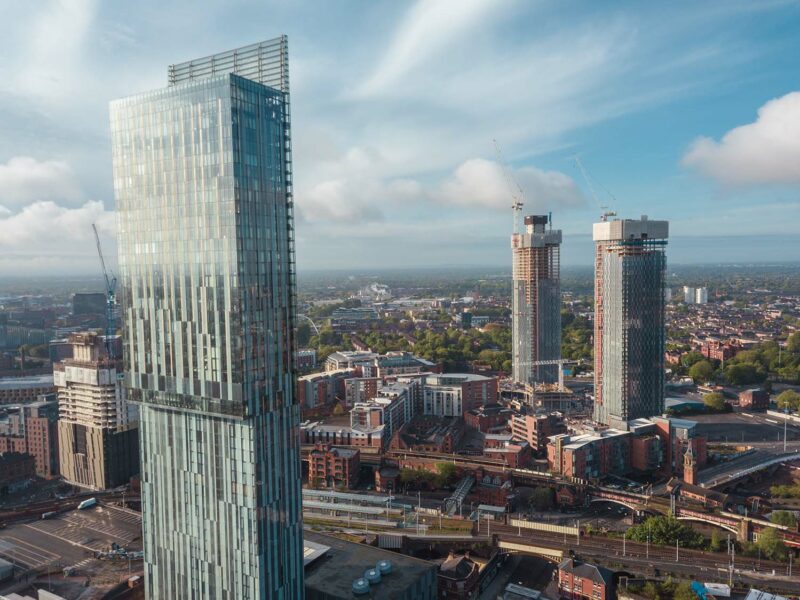Retail Construction and Refurbishment Market Report – UK 2018-2022
Available as an Instant Download PDF
The 5th edition of the Retail Construction and Refurbishment Market Report UK 2018-2022 analyses the key issues underpinning the UK retail sector and focuses on the long-term estate strategies and construction and development programmes of the leading retailers in both the grocery and non-food sectors.
£700.00 Exc. VAT
The 5th edition of the ‘Retail Construction and Refurbishment Market Report – UK 2018-2022’ analyses the key issues underpinning the UK retail sector and focuses on the long-term estate strategies and construction and development programmes of the leading retailers in both the grocery and non-food sectors. The report should be of particular interest to retailers, supply chains and construction professionals in the commercial retail sector.
Key issues covered in the report:
- Construction output in the retail sector.
- Structure, size and value of the UK retail sector – retail sales growth 2012-2017 and forecasts to 2022.
- Retail construction supply chains: Tesco; ASDA; Sainsbury’; Morrisons; Waitrose; Lidl; Aldi; Co-operative.
- Detailed analysis of issues affecting retail construction.
- Review of key construction companies and contractors in the retail sector.
Areas of particular interest:
- The structure and size of both the grocery and non-food sectors (including convenience, discount and online retailing), together with projections for growth over the next few years and key drivers of expansion in the retail sector including convenience and online.
- Current and future development pipelines and expansion plans of the ‘big four’ supermarkets, discounters and convenience store chains as well as non-food multiples and major department stores.
- Detailed assessment of retail new build construction output, RMI and shopfitting, together with estimated forecasts for growth over the next few years.
Some of the companies included:
Alan Nuttall Partnership, Barnwood Shopfitting, Bowmer & Kirkland, Bridgford Interiors, British Land, Caddick, Cardinal Shopfitting, Clegg Construction, Commercial Development Projects, Conamar Construction, CTS (Shopfitting), Ellmer & Chorus, Fit Out UK, Goodman Hichens, Hammerson, Havelock Europa, Harvey Shopfitters, Henry Boot, Intu, ISG, Jessops Construction, Kier, Land Securities, MACE, McLaughlin & Harvey, McLaren Construction, Morris & Spottiswood, Muir Construction, Portview Fit-Out, Powells Group, Railston, RG Group, Readie Construction, Seddon Construction, SFD -UK, Simons Group, Simpson (York), Speller Metcalfe, Styles & Wood, Tolent, Willmott Dixon, Winvic Construction and more.
RETAIL CONSTRUCTION AND REFURBISHMENT
- Construction market overview: total construction output to 2022; non-residential construction output; output by sub-sector.
- Construction output in the retail sector & shopfitting market in the UK.
- Building programmes in the retail sector: overview; current trends in store size and formats.
- Retail development pipeline, shopping centre development.
- Grocery retail development pipeline; grocery pipeline – impact on construction contractors.
- Building programmes and expansion plans leading retailers: grocery retail; non-food retail.
ISSUES AFFECTING RETAIL CONSTRUCTION
- Planning issues: overview; changes to the national planning policy framework (NPPF).
- Other issues: change of use legislation; business rates; rise of online retailing; etc.
- The Grimsey and Portas reviews – an update.
- Land and planning issues – the ‘Big Four’ supermarkets land and development activities.
- Sustainable construction in the retail sector: retailer progress on reducing carbon emissions; BREEAM rating for retail.
RETAIL MARKET IN THE UK
- Structure, size and value of the UK retail sector; retail sales and consumer spending.
- Store closures/administrations in the retail sector.
- The grocery market: overview and market size and structure; Sainsbury’s/ASDA merger 2018.
- Leading supermarket chains and superstores – company overview; property portfolio, future plans: Tesco; ASDA; J Sainsbury; WM Morrison; other supermarket groups.
- Convenience retailing; discount/value retailing.
- Non-food retailing: clothing & footwear; electrical appliances & consumer electronics; DIY & hardware; furniture & furnishings.
- Leading non-food retailers, chains and department stores – expansion plans.
- Out of town retail parks/retail warehouse construction.
CONSTRUCTION SUPPLY IN THE RETAIL SECTOR
- Retail construction supply chains: Tesco; ASDA; Sainsbury’; Morrisons; Waitrose; Lidl; Aldi; Co-operative.
- Key construction companies and contractors in the retail sector.
- Value of construction projects by sub sector.
- Retail sector projects: contractor’s market share.
- Leading contractors in the grocery/food retail sector & the general retailing sector; retail contractor profiles.
- Leading shopfitting companies & leading developers in the retail sector.
Over the last 10 years retail construction output has been on an underlying downward trend, firstly because of the recession and subsequently because of pressure on the housing sector and uncertainties surrounding ‘Brexit’. Between 2007 and 2017, contractors output declined from £8.3bn to £6.1bn, and annual growth since 2015 has been static.
At a sub-sector level, fortunes have been mixed with expansion within the discount sector but a reduction in newbuild and output in the supermarket and High Street segments. The race to build large superstores in the grocery sector has now all but ended and larger retailers are being forced to re-evaluate their property portfolios in the face of increased competition from the value and convenience retailers and from online and ‘click and collect’ services. Sub-letting and re-purposing space is being deployed at both existing and new stores, particularly at out-of-town locations
Retail construction, whilst challenging for the contractor and offering slim margins, does offer repeated high volumes of work, especially in the grocery sector. In the discount grocery sector, where expansion programmes have remained relatively strong so far has been an area offering opportunities for contractors, which helped to maintain order books and work pipelines.
The continued trend for many retail projects is now for inclusion within mixed use developments and there has been a significant shift from purely retail-driven outlets to ‘destination’ mixed retail, leisure and family entertainment venues. The extent and speed of the recovery for retail remains heavily dependent upon levels of consumer confidence and spending, which are currently being impacted by the ongoing uncertainty surrounding the Brexit process.
Contents Listing
- 1. INTRODUCTION 6
- 1.1 BACKGROUND 6
- 1.2 SOURCES OF INFORMATION 6
- 2. SUMMARY 8
- 2.1 MARKET PERFORMANCE 8
- 2.2 FUTURE PROSPECTS 9
- 3. ECONOMIC ENVIRONMENT 12
- 3.1 GDP 12
- 3.2 INFLATION & INTEREST RATES 13
- 3.3 UNEMPLOYMENT 14
- 3.4 HOUSEHOLD CONSUMPTION 14
- 3.5 HOUSING & CONSTRUCTION 15
- 3.6 STERLING 16
- 3.7 POPULATION PROFILE 16
- 3.8 CONCLUSIONS 17
- 4. RETAILING MARKET 18
- 4.1 OVERVIEW 18
- 4.2 RETAIL SALES AND CONSUMER SPENDING 19
- 4.2.1 Store Closures/Administrations 19
- 4.3 RETAIL MARKET SEGMENTATION 21
- 4.3.1 Grocery retailing 21
- 4.3.2 Hypermarkets, superstores & supermarkets 22
- 4.3.3 Convenience / Local Stores 22
- 4.3.4 Discount Retail 24
- 4.4 GENERAL RETAILING / NON- GROCERY 25
- 4.5 E-COMMERCE 26
- 5. RETAIL CONSTRUCTION MARKET 28
- 5.1 RECENT OUTPUT PERFORMANCE 28
- 5.2 MARKET PROSPECTS 29
- 5.3 MARKET INFLUENCES 31
- 5.3.1 Growth in Online Shopping 31
- 5.3.2 National Planning Policy Framework 32
- 5.3.3 Changes in Store Formats 33
- 5.3.4 Change of Use Legislation 35
- 5.3.5 Business Rates 35
- 5.3.6 Land and Planning Issues 36
- 5.3.7 Shortages in Traditional Construction Skills 37
- 6. MARKET SEGMENTATION 39
- 6.1 MARKET 39
- 6.2 GROCERY LED MULTIPLES 39
- 6.3 GENERAL RETAILING / HIGH STREET STORES 42
- 6.4 SHOPPING CENTRES 44
- 6.5 RETAIL PARKS/RETAIL WAREHOUSES 46
- 7. CONTRACTING IN THE RETAIL SECTOR 48
- 7.1 PROCUREMENT 48
- 7.2 MAIN CONTRACTORS REVIEW 49
- 7.2.1 Main Contractors 50
- 7.2.2 Leading Shopfitting Companies 52
- 7.3 LEADING DEVELOPERS IN THE RETAIL SECTOR 55
Tables & Charts
- CHART 1: RETAIL CONSTRUCTION OUTPUT (GB) NEW WORK ANALYSIS 2013 TO 2022 – BY VALUE (£BN AT CURRENT PRICES) 8
- TABLE 2: GDP DATA – 2015-2018 – KEY CONSTITUENT ELEMENTS 12
- CHART 3: INTEREST RATES AND INFLATION (CPI) FROM 2000-2022 14
- CHART 4: PDI & SAVINGS RATIO AT CURRENT PRICES 2000-2022 15
- TABLE 5: EXCHANGE RATE FLUCTUATIONS 2014-2020 – STERLING TO THE DOLLAR, AND THE EURO, SPOT RATES 16
- CHART 6: NUMBER OF RETAIL ENTERPRISES IN THE UK 2009-2017 18
- TABLE 7: UK RETAIL SALES GROWTH 2012-2017 AND FORECASTS TO 2022 19
- TABLE 8: UK GROCERY SECTOR (TURNOVER SIZE AND MARKET SHARE) BY VALUE (£BN) 2018 AND FORECAST 2023 21
- TABLE 9: UK GROCERY MARKET MAJOR MULTIPLES SHARES: AS AT MAY 2018 21
- TABLE 10: SPECIALIST CONVENIENCE STORE GROUPS- NUMBER OF OUTLETS, MARKET SHARE AND TURNOVER (£BN) 2015 & 2018 22
- CHART 11: UK CONVENIENCE SECTOR BY NUMBER OF OUTLETS BY FORMAT 2017/18 23
- TABLE 12: LARGEST DISCOUNT STORE OPERATORS IN THE UK – STORE PORTFOLIOS, EXPANSION PLANS AND TURNOVER (£BN) 2015 & 2018 24
- TABLE 13: UK NON-GROCERY RETAILING BY MAIN PRODUCT GROUP BY VALUE 2017 25
- CHART 14: RETAIL CONSTRUCTION – CONTRACTORS NEW WORK OUTPUT (£BN AT CURRENT PRICES) 2013-2017 AND FORECASTS 2018 -2022 28
- CHART 15: UK RETAIL DEVELOPMENT PIPELINE (SHOPPING CENTRES, RETAIL PARKS AND SUPERMARKETS) BY AREA (MILLION FT2) 2017-2020 30
- CHART 16: ONLINE SALES REVENUES FOR E-TAILERS AND MULTI-CHANNEL RETAILERS IN 2017-18 – BY VALUE (£BN) 32
- TABLE 17: SUPERMARKET PLANNING CONSENTS BY GIFA (FT2) 2017-18 35
- TABLE 18: UK CONSTRUCTION INDUSTRY BY PROFESSION, 2012-2022 (NUMBER OF WORKERS) 38
- CHART 19: UK RETAIL SECTOR – CONTRACT AWARDS BY SUB SECTOR MAY 2017 TO JUNE 2018 39
- CHART 20: UK PIPELINE FOR GROCERY RETAIL SPACE (PROPOSED, WITH CONSENT AND UNDER CONSTRUCTION) BY AREA (FT2 (MILLIONS) 2017-20 40
- TABLE 21: LEADING GROCERY RETAILERS: PLANNING APPLICATIONS SUBMITTED – 2017/18 40
- CHART 22: UK SHOPPING CENTRES FLOORSPACE – MILLION FT2) 2013-2020 44
- TABLE 23: MAJOR SHOPPING CENTRE CONSTRUCTION PROJECTS 2018 – 2020 45
- CHART 24: RETAIL WAREHOUSE DEVELOPMENT PIPELINE (PROPOSED, WITH CONSENT, UNDER CONSTRUCTION AND TOTAL PIPELINE): BY AREA (MILLION FT2) 2017 – 2020 46
- TABLE 25: LEADING MAIN CONTRACTORS IN THE RETAIL SECTOR (FOOD & NON-FOOD) – JUNE 2016 – MAY 2018 BY NUMBER AND VALUE OF CONTRACTS WON (£M) 50
- TABLE 26: MAJOR SHOPFITTING COMPANIES LEAGUE TABLE 2017 (BY SALES AND RETAIL CLIENTS) 54
- TABLE 27: LEADING RETAIL DEVELOPERS IN THE UK – CURRENT PROPERTY PORTFOLIOS 2018: MAJOR PROJECTS, FUTURE INVESTMENTS AND DEVELOPMENT PLANS 56

Paired Report Discount
Save £250 for every two reports you buy
Discount applied in basket
Frequently bought together

Trusted by industry leaders
For more detailed requests speak to our research experts directly
By using this form you agree that your data will be processed and protected in line with our Privacy Policy.
Research you can depend on
Our reports go deeper to give you the insights needed to make your next strategic move.
- Detailed assessment of the market – analysis of the market structure and recent developments within the market.
- Market prospects up to 4 years – market value, opportunities, impact of Covid-19, Brexit etc.
- Detailed information – market size, influences, market factors and key players.
- Analysis by product group – market size, product mix, sector trends etc.





